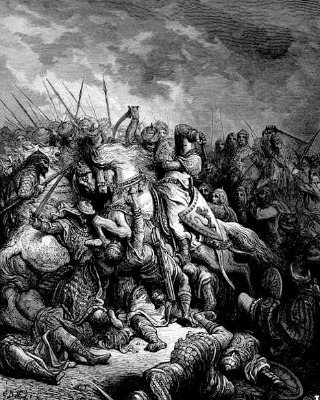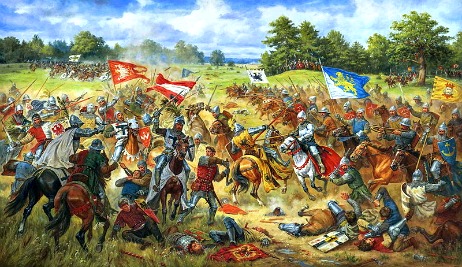The History of Medieval Knights
What are Knights?
The medieval knight was an elite type of warrior usually drawn from the aristocratic families of Europe.
They were sworn to fight for their liege lord and
in return could gain land and riches as a reward for their service and from the spoils of war.
They were predominantly mounted cavalrymen and may have evolved into the elite
fighting force they became as a direct response to Muslim incursions into Christian Spain in the eighth century.
Talk the Talk
The exact origins of the word knight are unknown but it may derive from the old German word knecht and/or the Anglo-Saxon word cniht.
Both these words refer to a servant or bondsman and reflect the fact that the knight’s main duty was to serve his lord on the battlefield.
 Becoming a knight was not easy and required years of hard work and service. As a young boy, usually around seven years old, a nobleman’s son
destined for this path would be sent to live in a lord's castle. He would first train as
a page and be expected to deliver messages, clean clothes and weapons, and serve the household as required. In return, he would get an education in matters that would help him in his future career such as learning aspects of the chivalric code, horsemanship and
basic combat skills.
Becoming a knight was not easy and required years of hard work and service. As a young boy, usually around seven years old, a nobleman’s son
destined for this path would be sent to live in a lord's castle. He would first train as
a page and be expected to deliver messages, clean clothes and weapons, and serve the household as required. In return, he would get an education in matters that would help him in his future career such as learning aspects of the chivalric code, horsemanship and
basic combat skills. At around fourteen years old, the child would become a squire,
serving as an apprentice to a knight and assisting him with tasks such as polishing his weapon and armour, carrying his shield, saddling his horse and sometimes taking the knight's flag into
battle. The boy would again get educated in return for his service with more advanced combat skills, strategies of war and gaining battlefield experience.
After years of training, a squire would finally be knighted around the age of twenty-one after proving
himself worthy of fighting for his lord. The ceremony would consist of the lord giving a light blow with the flat of his sword on the neck or the shoulder. However, later in the period, the affair became more elaborate and included a vigil at an altar before the knighting took place.
Orders of Knighthood
While many knights were landowners who earned their holdings through service to
their lord, many others were landless. As a result, from around the beginning of the twelfth century, some of the great military Knightly Orders began to appear, largely populated by landless
knights. The most important and powerful of these orders included:
- The Knights Templars
- The Knights Hospitallers
- The Teutonic Knights
- The Livonian Brothers of the Sword
- The Knights of Calatrava
- The Knights of Aviz
Not only were these military bodies, but they were also religious houses
which left a conflict of interest that was never fully resolved. As their purpose for existing was to fight for the Catholic Church, they had to break the sixth commandment, Thou Shalt Not
Kill. This contradiction was at least partly resolved with the onset of the Crusades
with the declaration that it only applied to fellow Christians, therefore killing Muslims was not a sin against God. There were also secular orders similar to the religious ones but founded by kings or high-ranking nobles such as the
Order of the Garter in England and the Order of the Golden Fleece in Burgundy.
The Feudal System
While modern historians generally agree the feudal system never really existed in the
strictest sense of the word, it does act as a useful umbrella term to provide an insight into the structure of medieval society. Social rank could be said to be divided into four distinct categories;
- The king and his family
- The barons who were made the lords of large tracts of land in return for loyalty to the king and who were expected to provide troops in times of war
- The knights who were the elite fighting men loyal to the barons and the king
- The peasants who were the workforce of a country, predominantly employed in agriculture
The Chivalric Code
The concept of chivalry first
emerged in France around the tenth century as a result of regulations brought in by the Christian Church in a bid to control the violent Frankish
society. All knights were required to strive to live by the chivalric code and while there was no one document laying out what
chivalry actually was, there were rules that were generally agreed upon by the nobility of medieval Europe.
Similar to the famous Bushido Code of Japan, a knight was required to be loyal, courageous and always
ready to fight for his lord. It was also a moral code that set out how he should behave when not in battle. A knight was expected to be courteous, honourable and to always show
gallantry towards women, qualities that have led to an idealised view of the medieval knight. However, these standards were not always lived up to. The middle ages were violent and bloody times and many knights as
‘men of their time’, while effective on the battlefield, fell short of living up to the code of chivalry.
The Tournament
The tournament was an important aspect of medieval culture and provided a knight with the chance to practice various forms of fighting including jousting, sword fighting, archery and hand-to-hand combat. The knight with the best record at the end of the contest would be awarded a prize, which would often be a financial reward.
According to Roger of Hoveden, an English chronicler employed by King Henry II (1133 - 1189), tournaments were, “Military exercises carried out, not in the spirit of hostility but solely for practice and the display of prowess.” Hundreds would take part in the tournament and often thousands of spectators would come to the colourful and exciting events which would take place over several days.
There would be both individual and team events and while the fighting was done in a friendly manner, injuries could affect as many as ten per cent of the competitors.
Fatalities were also commonplace, so much so that in 1292, the Statute of Arms for Tournaments was ordained which laid down safety laws which included weapons should be blunt and that medics should be present at all events.
Weapons and Armour
Armour was very important to a knight and was very expensive as it had to be tailor-made as an ill-fitting set of armour would slow him down on the battlefield. It also acted as a status symbol as the more affluent knights could afford the best armour money could buy. It consisted of an array of garments, chain mail and iron plates and even the knight’s horse would often be fitted with protective armour to help prevent its rider being forced to dismount in battle.
As new weapons were introduced, and others improved in design during the medieval period, the armour worn by knights also evolved to compensate. Plate armour was introduced during the latter part of the thirteenth century and full plate armour came into use during the fifteenth century. One of the knight’s main weapons of choice was the broad sword which would be carried on his belt along with a dagger known as a roundel. Spikes known as gadlings were attached to the knuckles of his gauntlets to use as kind of knuckle dusters in hand-to-hand combat.
A shield would be carried for defence and would usually display the house crest of the knight and when fighting on his horse as was usually the case, his other hand could carry a lance. The era of the knight as the most important part of an army started around the eleventh century and played an important role in the culture of the ruling elites of Europe. However, with the introduction of firearms, artillery and the use of mercenary armies which proved to be not only more effective on the battlefield but also a lot less expensive, the influence of the medieval knight began to wane and by the sixteenth century, was a thing of the past.
Written by Andrew Griffiths – Last updated 27/06/2023. If you like
what you see, consider following the History of Fighting on social media.
Further Reading:
Knight. [Internet]. 2018. Encyclopedia.com. Available From:
http://www.encyclopedia.com/history/modern-europe/heraldry-knighthood-and-chivalry/knights [Accessed Sept 04, 2018].
Linda Alchin. [Internet]. 2018. Medieval Knights. Medieval Life and Times. Available From: http://www.medieval-life-and-times.info/medieval-knights [Accessed Sept 04, 2018].
Sarah Douglas. [Internet]. 2011. Chivalry in Medieval England. Ohio State University. Available From: http://origins.osu.edu/review/knighthood-it-was-not-we-wish-it-were [Accessed Sept 04, 2018].
The Feudal System and the Domesday Book. [Internet]. 2018. BBC. Available From: https://www.bbc.com/bitesize/guides/zdvdmp3/revision/1 [Accessed Sept 04, 2018].
The images on this site are believed to be in the public domain, however, if any mistakes have been made and your copyright or intellectual rights have been breeched, please contact andrew@articlesonhistory.com.

